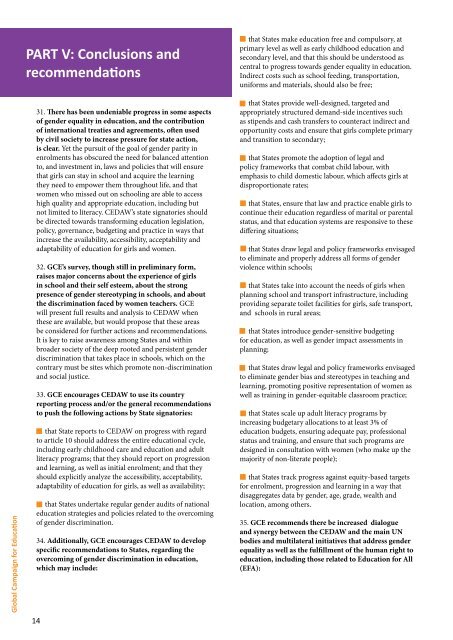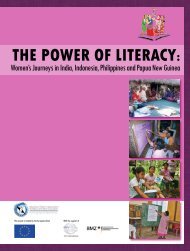Gender Discrimination in Education: The violation of rights of women ...
Gender Discrimination in Education: The violation of rights of women ...
Gender Discrimination in Education: The violation of rights of women ...
You also want an ePaper? Increase the reach of your titles
YUMPU automatically turns print PDFs into web optimized ePapers that Google loves.
Global Campaign for <strong>Education</strong><br />
PART V: Conclusions and<br />
recommendations<br />
31. <strong>The</strong>re has been undeniable progress <strong>in</strong> some aspects<br />
<strong>of</strong> gender equality <strong>in</strong> education, and the contribution<br />
<strong>of</strong> <strong>in</strong>ternational treaties and agreements, <strong>of</strong>ten used<br />
by civil society to <strong>in</strong>crease pressure for state action,<br />
is clear. Yet the pursuit <strong>of</strong> the goal <strong>of</strong> gender parity <strong>in</strong><br />
enrolments has obscured the need for balanced attention<br />
to, and <strong>in</strong>vestment <strong>in</strong>, laws and policies that will ensure<br />
that girls can stay <strong>in</strong> school and acquire the learn<strong>in</strong>g<br />
they need to empower them throughout life, and that<br />
<strong>women</strong> who missed out on school<strong>in</strong>g are able to access<br />
high quality and appropriate education, <strong>in</strong>clud<strong>in</strong>g but<br />
not limited to literacy. CEDAW’s state signatories should<br />
be directed towards transform<strong>in</strong>g education legislation,<br />
policy, governance, budget<strong>in</strong>g and practice <strong>in</strong> ways that<br />
<strong>in</strong>crease the availability, accessibility, acceptability and<br />
adaptability <strong>of</strong> education for girls and <strong>women</strong>.<br />
32. GCE’s survey, though still <strong>in</strong> prelim<strong>in</strong>ary form,<br />
raises major concerns about the experience <strong>of</strong> girls<br />
<strong>in</strong> school and their self esteem, about the strong<br />
presence <strong>of</strong> gender stereotyp<strong>in</strong>g <strong>in</strong> schools, and about<br />
the discrim<strong>in</strong>ation faced by <strong>women</strong> teachers. GCE<br />
will present full results and analysis to CEDAW when<br />
these are available, but would propose that these areas<br />
be considered for further actions and recommendations.<br />
It is key to raise awareness among States and with<strong>in</strong><br />
broader society <strong>of</strong> the deep rooted and persistent gender<br />
discrim<strong>in</strong>ation that takes place <strong>in</strong> schools, which on the<br />
contrary must be sites which promote non-discrim<strong>in</strong>ation<br />
and social justice.<br />
33. GCE encourages CEDAW to use its country<br />
report<strong>in</strong>g process and/or the general recommendations<br />
to push the follow<strong>in</strong>g actions by State signatories:<br />
that State reports to CEDAW on progress with regard<br />
to article 10 should address the entire educational cycle,<br />
<strong>in</strong>clud<strong>in</strong>g early childhood care and education and adult<br />
literacy programs; that they should report on progression<br />
and learn<strong>in</strong>g, as well as <strong>in</strong>itial enrolment; and that they<br />
should explicitly analyze the accessibility, acceptability,<br />
adaptability <strong>of</strong> education for girls, as well as availability;<br />
that States undertake regular gender audits <strong>of</strong> national<br />
education strategies and policies related to the overcom<strong>in</strong>g<br />
<strong>of</strong> gender discrim<strong>in</strong>ation.<br />
34. Additionally, GCE encourages CEDAW to develop<br />
specific recommendations to States, regard<strong>in</strong>g the<br />
overcom<strong>in</strong>g <strong>of</strong> gender discrim<strong>in</strong>ation <strong>in</strong> education,<br />
which may <strong>in</strong>clude:<br />
14<br />
that States make education free and compulsory, at<br />
primary level as well as early childhood education and<br />
secondary level, and that this should be understood as<br />
central to progress towards gender equality <strong>in</strong> education.<br />
Indirect costs such as school feed<strong>in</strong>g, transportation,<br />
uniforms and materials, should also be free;<br />
that States provide well-designed, targeted and<br />
appropriately structured demand-side <strong>in</strong>centives such<br />
as stipends and cash transfers to counteract <strong>in</strong>direct and<br />
opportunity costs and ensure that girls complete primary<br />
and transition to secondary;<br />
that States promote the adoption <strong>of</strong> legal and<br />
policy frameworks that combat child labour, with<br />
emphasis to child domestic labour, which affects girls at<br />
disproportionate rates;<br />
that States, ensure that law and practice enable girls to<br />
cont<strong>in</strong>ue their education regardless <strong>of</strong> marital or parental<br />
status, and that education systems are responsive to these<br />
differ<strong>in</strong>g situations;<br />
that States draw legal and policy frameworks envisaged<br />
to elim<strong>in</strong>ate and properly address all forms <strong>of</strong> gender<br />
violence with<strong>in</strong> schools;<br />
that States take <strong>in</strong>to account the needs <strong>of</strong> girls when<br />
plann<strong>in</strong>g school and transport <strong>in</strong>frastructure, <strong>in</strong>clud<strong>in</strong>g<br />
provid<strong>in</strong>g separate toilet facilities for girls, safe transport,<br />
and schools <strong>in</strong> rural areas;<br />
that States <strong>in</strong>troduce gender-sensitive budget<strong>in</strong>g<br />
for education, as well as gender impact assessments <strong>in</strong><br />
plann<strong>in</strong>g;<br />
that States draw legal and policy frameworks envisaged<br />
to elim<strong>in</strong>ate gender bias and stereotypes <strong>in</strong> teach<strong>in</strong>g and<br />
learn<strong>in</strong>g, promot<strong>in</strong>g positive representation <strong>of</strong> <strong>women</strong> as<br />
well as tra<strong>in</strong><strong>in</strong>g <strong>in</strong> gender-equitable classroom practice;<br />
that States scale up adult literacy programs by<br />
<strong>in</strong>creas<strong>in</strong>g budgetary allocations to at least 3% <strong>of</strong><br />
education budgets, ensur<strong>in</strong>g adequate pay, pr<strong>of</strong>essional<br />
status and tra<strong>in</strong><strong>in</strong>g, and ensure that such programs are<br />
designed <strong>in</strong> consultation with <strong>women</strong> (who make up the<br />
majority <strong>of</strong> non-literate people);<br />
that States track progress aga<strong>in</strong>st equity-based targets<br />
for enrolment, progression and learn<strong>in</strong>g <strong>in</strong> a way that<br />
disaggregates data by gender, age, grade, wealth and<br />
location, among others.<br />
35. GCE recommends there be <strong>in</strong>creased dialogue<br />
and synergy between the CEDAW and the ma<strong>in</strong> UN<br />
bodies and multilateral <strong>in</strong>itiatives that address gender<br />
equality as well as the fulfillment <strong>of</strong> the human right to<br />
education, <strong>in</strong>clud<strong>in</strong>g those related to <strong>Education</strong> for All<br />
(EFA):
















